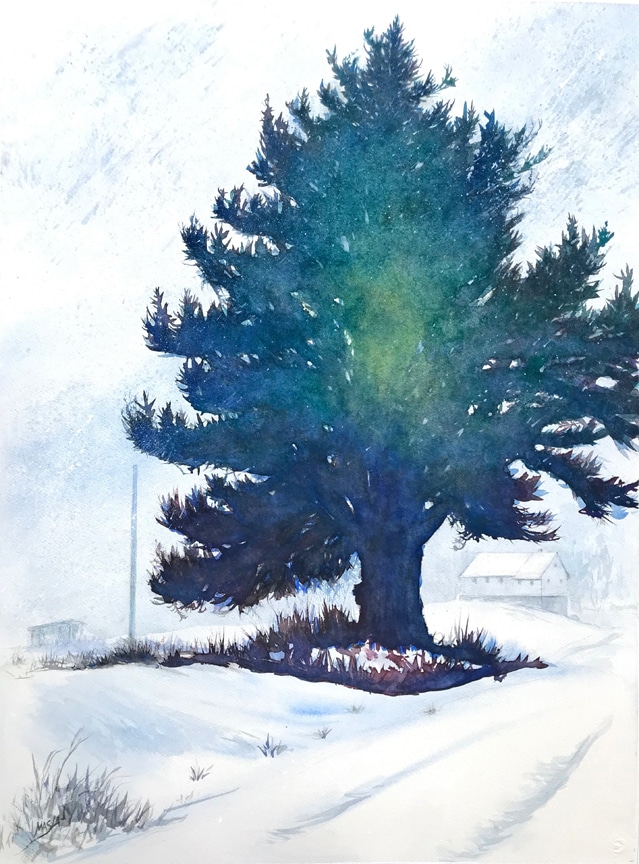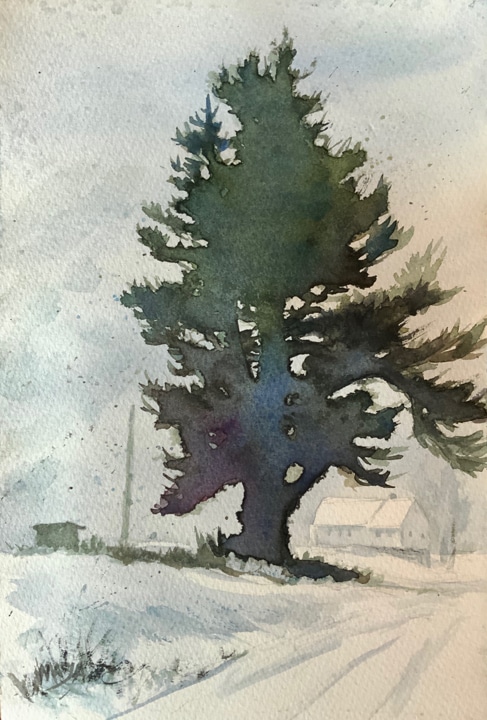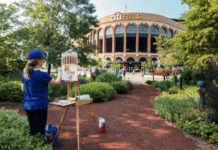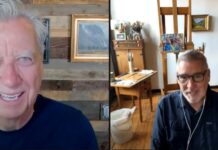BY BOB MASLA
When I had returned from Mexico to my home and studio in western MA in the very beginning of April, the Virus was in full swing and the “craziness” had just begun. Returning from Mexico each year, there is always a span of time which I need for adjustment, certainly because of the weather, but there is also the “culture shock.” This year of course was unprecedented, and as I re-immersed in the “news” of our culture and the world in general (I try and avoid the news as much as possible in Mexico), I felt a sense (certainly justified), of national, if not international fear and despair.
Later that week we had blizzard-like snow storms. I had not painted a snow scene in about 15 years, so I got excited. Not used to being in the cold, I drove up the road with camera and sketchbook, looking for the external image to match my inspiration.
There it hit me. I pulled the car over toward the top of our road. In front of me, through the swirling wind and heavy snow stood this massive tree. It dominated my view, with the farm house in the distance, diminished by the snowy atmosphere. It had an iconic feel. The tree felt strong and firm against the onslaught of the intense weather – it spoke to me of the need to have strength of inner resolve.
I often pass this tree in my morning walks and have painted it as part of other plein air paintings in the past. I have always said, art affords us the opportunity to see things afresh, with the eyes of a child, as if for the first time, each time. As artists, we develop awareness, and with awareness, among many things we also realize, to paraphrase Heraclitus, “you cannot stick your foot in the same river twice.”
The image also reminded me of a painter that had inspired me back in the late 70’s and early 80’s, Caspar David Friedrich (1774 – 1840), the “father of German Romantic Painting.” Friedrich was arguably one of the pivotal figures in raising landscape painting to a level of importance and independence equal to religious painting (for him it was the same thing). and setting it on a path of independence. He infused his landscape paintings with symbolic meanings and composition. Fir trees, for example, often represented faith and hope.
I have nodded to Friedrich in paintings in my past and this felt similar, yet different. I wanted to capture the power of the image of that tall strong pine and the atmosphere of the scene, but I also wanted to paint what it was representing and what it felt to me. At this time of fear and uncertainty I wanted it to inspire strength, determination, and fortitude. I wanted to, as one critic once wrote of my work, “not just paint the external form of light, but the internal light as well.”
I went back to the studio, with sketch, photo, and inspiration (charged with observation and memory, two other important key components of art making), all close at hand.
I pulled out a quarter sheet, (roughly 11″ x 7”) of 140-lb Gemini cold press watercolor paper (the paper is not a bright white, but has a slightly buff warmth to it – see note #1 on paint, papers and brushes below).
With a mechanical pencil, I quickly dashed off the loose markings of the composition. I then soaked sections of the paper with water, careful to leave areas of the paper untouched that I wanted to remain “white.” I then dropped in a light wash of Paynes Grey, (each manufacturer creates this differently; in the Rembrandt colors I use, this is a mixture of Carbon Black and Phthalo Blue).
I mixed this with a little cobalt blue to cool it a bit more, both on my palette and blending it on the paper (see note #2 on using black and white and painting as a process below as well).
As the initial wash of colors began to dry to the point that edges could be controlled between soft and hard, I added a little Ultramarine blue to some of the mix to both spatter and texture the appearance of the snow. I also used a slightly warmer, very light value mix of ultramarine blue and Neutral Tint, (a warm grey, that is in Rembrandt colors, a mixture of Carbon Black and Quinacridone Rose) to create the farmhouse in the back so it would separate ever so slightly from the atmosphere. I used this in the forward snowbank on the left, and the strokes in the road and a little in the sky as well.
I then added a little Chromium Green mixed with the Neutral Tint (this “neutralized” or greyed the green a little) and used a sumi-e brush to lay in the pole and shack on the left and a light value wash for the first pass of the tree, creating a silhouette shape.
As this began to dry, using the sumi-e brush, I wet a new silhouette of the tree, slightly off register from the first one, and began literally dropping in colors with my mock squirrel brush, loading it with water and then a color and “squeezing” these different colors over different areas of the wet tree. From the green and cad yellow lemon, down to the Ultramarine Blue with drops of Permanent Red Violet and brushings of Sepia, (a mixture of Black and Venetian Red) as well.
At the appropriate interval of the drying process I sprayed this mingling wash with alcohol, which disperses the pigment and forces it into areas of concentration (in this case the edges, some of which I mopped up with paper towel) and leaving a lighter “inner glow” towards the center.
I have since done a larger, full sheet (30” x 22”) version, changing the colors a bit, shifting to a yellow glow in the center, as well as the form of the tree, making it “bulkier.” I will often do a number of versions from a source of inspiration, sometimes varying the medium with my intention.

#1 On Paper, Paints, and Brushes for this Watercolor Painting:
Paper: I use a variety of papers, Gemini, Fabriano, Kilimanjaro, Rembrandt blocks and occasionally Arches
Paints: Royal Talens’ Rembrandt Watercolors
Brushes: I have a huge selection of brushes that I have acquired over the course of approximately 45 years of watercolor painting, a number of them given to me from artist colleagues that come to teach at the Casa. They range from Kolinsky’s to old worn out bristle oil brushes I might use for scrubbing or and blending. Some of my current favorite go-to brushes are the Neptune and Elite made by Princeton. These are amazing synthetics that mimic a Kolinsky (at a fraction of the price) and can withstand a good deal of abuse. I also have a nice collection of cherished Sumi-e brushes from China that my mom got for me on one of her trips there in the 70’s. That said, I typically may only use one main large brush, supplemented with three or four other brushes throughout the execution of a watercolor painting. They would most often be a medium size Sumi-e brush, a large #10 or #12 Round, Large 1“ Flat, a large #8 Quill or imitation Squirrel, and a #2 rigger or script liner, and the occasional old oil bristle brush.
I’ll also use a finger, a sponge, a water mister, alcohol mister, block out, a knife, or a stick – whatever is necessary to achieve the desired effect.
As I always tell my students and workshop participants: There is only one rule in creativity and the creation of a work of art and that is – There are No Rules. Creativity and it’s expression is infinite. That said, there are methods, techniques and concepts, that if you learn, can produce somewhat predictable results. And of course there are scientific principles one should learn, that if you choose to ignore, may effect the structural integrity of your piece (such as fat over lean in oil painting).
#2 Note on Color:
I should point out that I have no aversion to using either white or black, either to change the color, add opacity, reclaim a “lost” highlight, etc. if it serves the whole painting. It was the practice of many of the great masters of history (and many contemporary ones) and has many practical and aesthetic applications in watercolor painting.
I should also note here, I don’t consider myself a “watercolorist” or an “oil painter,” or any other such designation. I am first and foremost an artist, and that to me is a way of being in the world, a lifestyle, a world view – a process of being an aware, conscious, and sensitive human being, and one of the main practices I use to facilitate this awareness is through painting. The choice of medium for expression, (watercolor, oil, acrylic – or dance, poetry, music, writing, etc.), is determined mostly by the first two key ingredients – Inspiration and Intention.
Connect with Bob Masla at maslafineart.com.
> Click here to subscribe to the free newsletter, Plein Air Today
> And click here to subscribe to PleinAir Magazine so you never miss an issue!




